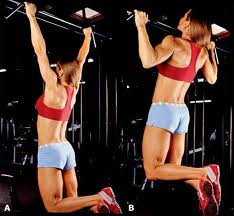When I walked into the gym yesterday, there was a group of guys in the squat rack doing upright rows and shrugs with less than 100 pounds. There was a lot of fist bumping. Next to them was a well-meaning kid doing half squats with weight most girls I know can squat to depth. Then I saw a guy exploring his 1RM nosebreaker without a spot (he barely survived). Later in the locker room I heard a guy who walks around like he’s impressive brag about his whey protein, “It’s got hydrolized and ionized whey in it. I can’t wait to have my two shakes every day.” I’m normally calm and under control, but these events made me want to flip out.
The to weak shruggers I’d shout, “YOU’RE NOT ACCOMPLISHING ANYTHING!”
To the nose breaker I’d shout, “WHY WOULD YOU HIT A 1 REP MAX IN THAT?”
To the protein braggart I’d shout, “DO YOU EVEN LIFT?”

I’m sick of rear flyes, upright rows, and Smith machines. I’m sick of 30 minute elliptical sessions, half squats, and triceps extensions. Most of all, I’m sick of seeing people misinformed. I wish I could help everyone, but not everyone believes they need help. Coercion is a simpleton’s game. What I can do instead is to make sure that you, the “well-informed reader” understand why you do what you do. In the event you’re asked about it, you can effectively share this information legitimately. That two minute conversation will make or break your friend’s acceptance of “training” instead of “fucking around”.
CONTINUE READING Continue reading
Monthly Archives: January 2012
Programming Pull-ups
Monday’s are devoted to female related topics to help females begin or continue to train.
In this post, about 40% of female poll-takers said that they couldn’t do a pull-up (while 7% said they could at least do a chin-up). In this post we talked about how to develop a chin-up (underhand) or pull-up (overhand), but only briefly talked about programming these methods. While the Frequency Method works well, there is some leeway on how to implement it. We’ll discuss how to go about improving the pull-up based on current ability, give tips about the Frequency Method, and offer some other methods.

What To Do
Here are the levels from no chin-up to pull-up (use this post for explanation). Note that the chin-up will develop first, so all movements focus on that unless otherwise noted.
CONTINUE READING Continue reading
Q&A – 16
Greetings lovely readers. I hope you had a jolly week. It’s PR Friday, so share your weekly PR’s and training updates. Today I want to hear what mobility concerns you have. In other words, what structures/joints do you need to work on the most?
Also, we will continue yesterday’s poll. If you already voted, please refrain from doing so.
[poll id=”36″]
This week started with a short video on Push-up cues that can specifically help females augment their strength training within the confines of a good externally rotated shoulder position. We then discussed what I call “Antagonistic Motivation” to provide long-term motivation in a program. On Wednesday we discussed the importance of keeping a good training log and Thursday we explained and discussed pulling styles in Olympic weightlifting.
CONTINUE READING Continue reading
“Jump/shrug” vs “Catapult”
[poll id=”36″]
The poll above will give some insight as to what style of training 70’s Big readers are distributed into. Weightlifters will be particularly interested in today’s topic while non-weightlifters will think it’s irrelevant, moot, or not understand it. I hope that the short analysis and discussion will spark some conversation related to mechanics as well as help the non-weightlifting crowd understand why the discussion exists.
Background
In a snatch or a clean, the barbell is pulled from the floor and moved upward because of the symphony of explosion from the knees and hips. The movements are more sensitive to technical changes that affect the mechanics, more so than strength lifts like the deadlift or press. This doesn’t mean weightlifting is on a pedestal with respect to powerlifting, it just means it’s very different. As with most sports, technique has evolved over time to improve efficiency, and this is evidenced by the progressive increase of world records over time (link shows WR total in “heavyweight” category 1972 to present).
The United States is so large and weightlifting is such a relatively small sport here that there is not a solidified way to teach mechanics. One would assume that the governing body, USA Weightlifting, would dictate the style of teaching, coaching, programming, and mechanics, but in practice this isn’t the case. Other countries that are successful in weightlifting will have a given system that they utilize, and discrepancies are either invalidated with research or results. Some systems of coaching or programming that come to mind are Bulgarian, Russian, and Chinese.
CONTINUE READING Continue reading
Logging Progress
Keeping a training log is incredibly important for all athletes, but especially for a strength trainee. Athletes and bodybuilders need to record their progress, yet athletes often do what they’re told and bodybuilders run a style of programming for a while and gauge progress by pictures. But for the strength trainee, numbers mean everything. If you lift more this week than you did a year ago, then you are obviously stronger. A training log easily quantifies progress and removes speculation and confusion. If you don’t keep a training log, then this post should convince you to do so. If you already keep one, this post may give you some additional variables to record or some ideas on how to organize the log itself.
What To Use
Any notebook will do, but notebooks without spirals will hold together. Composition books works really well, but they can still fall apart. Use duct or electrical tape to hold them together over the years and avoid turning the covers inside out. Chris has been using the same spiral notebook for several years, and it looks like he’s had it since fifth grade. The front cover is completely ripped off, but he keeps it on top as if it were still attached. The papers are loose, but some how he keeps it together enough where he can reference his training sessions (I’ve requested a picture). I don’t recommend this. Below are two types of notebooks that will hold up better:

The one on the left is a standard composition book, but with a leathery cover. The one on the right is a military field notebook; it was free and the cover is hard back and will hold up for a while. You can use whatever you want to, but I suggest picking something that will hold up for at least two years. My composition notebook above was used for at least 2.5 years.
CONTINUE READING Continue reading

